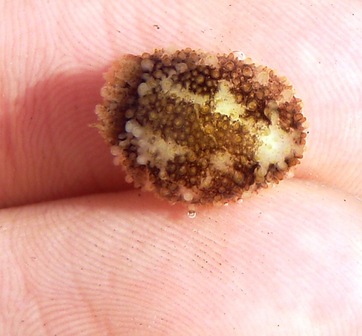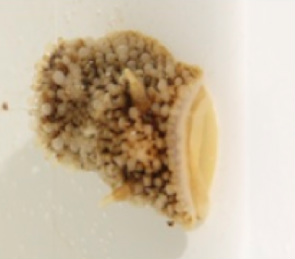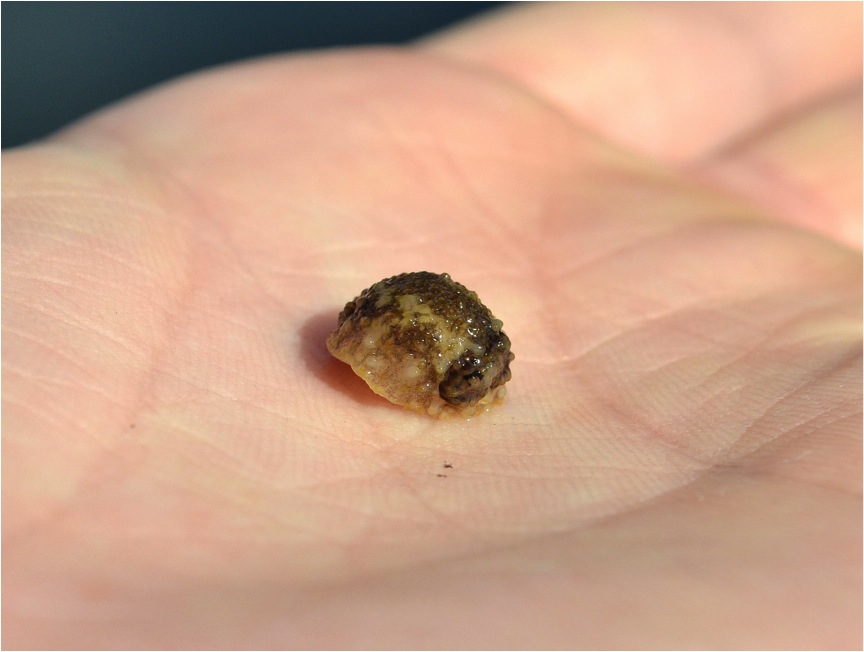Barnacle nudibranch, barnacle-eating dorid, rough-mantled doris • Onchidoris bilamellata
|
Top left and right: small even by its standards, this barnacle nudibranch was not even the width of one finger. It was found with around one hundred others of its kind, all feeding on barnacles on a dock piling on Calvert Island. Photos by Teegan Bennington (left) and Christian Kelly. Bottom left photo: rhinophores visible. Photo by Stuart Higgs.
|
Identification
This little dorid nudibranch reaches only 2 cm in length. Its cream-coloured, oval-shaped body is mottled with brown. Numerous small club-shaped papillae cover its dorsal side, giving it a rough-textured appearance. Its semicircular gill plume and rhinophores are retractable. Juveniles and the rare adult may be all white.
Habitat & Range
The barnacle nudibranch inhabits rocky areas of the intertidal zone, as well as shallower subtidal areas. As per its name, it can be found on and around barnacles — which it eats — as well as on rocks. It is often found in large aggregations. This species ranges along the coast of North America, from Alaska to Baja California in Mexico. It is also found on coastlines on both sides of the North Atlantic.
Intriguing Info
This nudibranch lays short, flat, snow white egg ribbons in the shape of a single curve or in waves.
This little dorid nudibranch reaches only 2 cm in length. Its cream-coloured, oval-shaped body is mottled with brown. Numerous small club-shaped papillae cover its dorsal side, giving it a rough-textured appearance. Its semicircular gill plume and rhinophores are retractable. Juveniles and the rare adult may be all white.
Habitat & Range
The barnacle nudibranch inhabits rocky areas of the intertidal zone, as well as shallower subtidal areas. As per its name, it can be found on and around barnacles — which it eats — as well as on rocks. It is often found in large aggregations. This species ranges along the coast of North America, from Alaska to Baja California in Mexico. It is also found on coastlines on both sides of the North Atlantic.
Intriguing Info
This nudibranch lays short, flat, snow white egg ribbons in the shape of a single curve or in waves.
References
Harbo, R. M. (1999). Whelks to whales: Coastal marine life of the Pacific Northwest. Madeira Park, BC: Harbour Publishing. P. 115.
Lamb, A., and Hanby, B. (2005). Marine Life of the Pacific Northwest [electronic version]. Madeira Park, BC: Harbour Publishing.
Picton, B.E. and Morrow, C.C. (2015). Onchidoris bilamellata (Linnaeus, 1767). Encyclopedia of Marine Life of Britain and Ireland. Accessed 19/08/2015.
Authors and editors of page
Kelly Fretwell and Brian Starzomski (2013).
Harbo, R. M. (1999). Whelks to whales: Coastal marine life of the Pacific Northwest. Madeira Park, BC: Harbour Publishing. P. 115.
Lamb, A., and Hanby, B. (2005). Marine Life of the Pacific Northwest [electronic version]. Madeira Park, BC: Harbour Publishing.
Picton, B.E. and Morrow, C.C. (2015). Onchidoris bilamellata (Linnaeus, 1767). Encyclopedia of Marine Life of Britain and Ireland. Accessed 19/08/2015.
Authors and editors of page
Kelly Fretwell and Brian Starzomski (2013).






